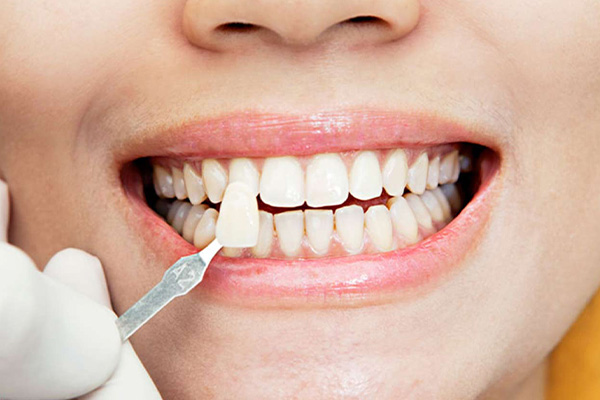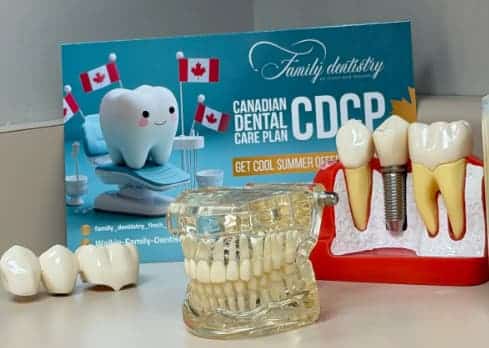If you are unhappy with your smile, you might be considering getting veneers or laminates to improve the appearance of your teeth. You might be wondering what the difference between these two options is (Dental Veneers vs Laminates), how they work, and what their pros and cons are. This is what this blog post is all about! We’ll cover everything you need to know about the differences between these two procedures, helpful facts, and insights to help you achieve the smile of your dreams.
What Are Dental Veneers and How Do They Work?
Dental veneers are exceptionally crafted shells meticulously designed to enhance the appearance and function of your teeth. Veneers can be made from several materials, including porcelain or resin composite. Porcelain veneers resist stains better than composite veneers and better mimic the light-reflecting properties of natural teeth.
The process often involves removing a small layer of enamel so the veneer can fit properly. Once the tooth is prepared, the dentist bonds the veneer to it with a strong adhesive. Veneers are a popular choice for covering chips, stains, gaps, or slightly misaligned teeth.

What Are Dental Laminates and How Do They Work?
Dental laminates are very similar to veneers but much thinner. They are designed to cover the front of the tooth and give it a fresh look, but unlike veneers, they usually require little to no enamel removal.
Because they are so thin, laminates are a less invasive option. The dentist simply bonds them to the tooth’s surface with special cement. Laminates are often chosen by patients who want cosmetic improvement without undergoing major dental preparation. They offer numerous benefits, such as:
- Covering chips, stains, cracks, and gaps between the teeth
- Improving the color and shape of the teeth
- Custom-fit for the most aesthetically pleasing result
- Providing a natural-looking appearance
Similar to porcelain veneers, laminates are created using molds carefully made from your teeth’s impressions. The custom-made covers are then cemented on your teeth and adjusted to perfection. So far, all these characteristics are shared between both dental veneers (especially porcelain veneers) and laminates, but what are their differences?

Dental Veneers vs Laminates: Key Differences You Should Know
At first glance, laminates and veneers may seem the same, but they have important differences. These differences are mainly about thickness, preparation steps, durability, and cost. Knowing them will help you choose the right option for your smile goals. Let’s take a quick look at laminate vs veneer teeth.
| Feature | Dental Veneers | Dental Laminates |
|---|---|---|
| Thickness | Thicker (0.5–1 mm) | Ultra-thin (0.2–0.3 mm) |
| Material | Porcelain or composite resin | Mostly porcelain |
| Tooth Preparation | Requires enamel removal (permanent) | Minimal to no enamel removal (less invasive) |
| Durability | Stronger, lasts 10–15 years with care | Slightly more fragile, lasts 8–10 years |
| Stain Resistance | Highly resistant to stains | Resistant, but slightly less than veneers |
| Best For | Mild cosmetic changes, preserving the natural tooth | Mild cosmetic changes, preserving natural tooth |
| Cost | More expensive due to detailed preparation and thicker material | Generally more affordable, but varies by dentist and material |
In the following sections, we explore these key differences in detail to help you decide which one is a better fit for your dental needs.
Thickness and Material Differences
Veneers are typically thicker, ranging from 0.5 to 1 mm, and can be made of porcelain or composite resin. Laminates, on the other hand, are ultra-thin, around 0.2–0.3 mm, and most often made of porcelain. Because of their thinness, laminates preserve more of the natural tooth structure.
Application and Procedure Steps
The process of getting veneers usually involves removing some enamel from the tooth’s surface. This step is permanent because enamel cannot grow back. Laminates, however, require little to no enamel removal. In some cases, this means the procedure can be reversed.
If you choose to get dental veneers, make sure to check out our guide to maintaining your dental veneers for long-lasting results.
Durability and Maintenance Needs
Veneers are known for their strength and can last 10 to 15 years with proper care. They resist stains and hold up well in daily use. Laminates also provide durability, but due to their thinness, they are slightly more fragile and typically last around 8 to 10 years. Both require the same daily care, including brushing, flossing, and regular dental visits.
For an in-depth analysis of porcelain laminate veneers’ long-term performance, check out this review on MDPI.
Price and Cost Comparison
In general, veneers are more expensive because they involve more preparation and thicker materials. Laminates are usually more affordable, though the price still depends on the dentist’s expertise and the material chosen.
The choice between veneers and laminates will depend on your specific dental needs and desired outcomes. It’s always best to consult with a dental professional to determine the most suitable option.

Advantages and Disadvantages of Dental Veneers
Dental veneers offer several advantages, such as:
- Natural-looking results
- Long-lasting and durable
- Resistant to stains and discoloration
- Effective for fixing chips, cracks, and gaps
However, you should be aware of the disadvantages they have, including:
- Require enamel removal (not reversible)
- More expensive than laminates
- If damaged, they usually need replacement, not repair
Advantages and Disadvantages of Dental Laminates
On the list below, you can see the advantages of dental laminates:
- Thinner, less invasive option
- Minimal to no enamel removal
- Preserve more of your natural tooth structure
- Provide a natural and attractive look
Once you choose this option, it’s wise to consider its disadvantages. For example, dental laminates are:
- Less durable compared to veneers
- More prone to chipping due to thinness
- Less likely to cover severe discoloration or major dental issues

Does the Difference between Veneers and Laminates Matter?
It matters, particularly when it comes to addressing your dental concerns and achieving the desired aesthetic outcome. Veneers are a versatile solution that can transform a smile with more extensive coverage, making them suitable for a wide range of dental issues such as severe discoloration, chips, or gaps.
They are thicker and require more tooth preparation, which means they can provide a substantial change in tooth shape, size, and color. This makes veneers an excellent choice for those looking for a significant smile makeover.
On the other hand, laminates, which are often synonymous with ultra-thin porcelain veneers, offer a less invasive option. They are ideal for patients who desire a cosmetic enhancement with minimal alteration to their natural teeth. Laminates are best suited for minor adjustments and are perfect for individuals who wish to improve their smile without the need for extensive dental work. The thinness of laminates allows for a highly conservative approach, preserving more of the natural tooth structure, which is always a positive aspect of dental treatment.
Final Word
Deciding on laminates vs veneers dental depends on your smile goals, the condition of your teeth, and how much natural enamel you want to preserve. Veneers are thicker, more durable, and ideal for covering major imperfections, while laminates are ultra-thin, less invasive, and perfect for subtle cosmetic improvements. Understanding their differences in thickness, procedure, durability, and cost can help you make an informed decision and achieve the smile you’ve always wanted.
How to Contact Walk-In Family Dental?
Connecting with Walk-In Family Dental is a straightforward process, ensuring that your dental inquiries or appointments are handled with ease.
- Phone Us: Give us a call at +1 (416) 742-1118 to speak directly with our friendly and knowledgeable staff. We’re here to assist you with any questions or to schedule your dental appointments conveniently.
- Email Us: For written correspondence or if you prefer electronic communication, you can reach us at info@walkinfamilydental.ca. Feel free to email us regarding inquiries, concerns, or appointment requests.
- Visit Us: Our dental practice is conveniently located at 2365 Finch Ave W #201, Toronto, ON M9M 2W8. If you prefer a face-to-face interaction, drop by our office, and our team will be delighted to assist you.
At Walk-In Family Dental, we prioritize open communication and accessibility, ensuring that your dental care experience is seamless and comfortable. Feel free to reach out through your preferred method, and get in touch with our cosmetic dentist in North York.
FAQ
Which is better veneer or laminate teeth?
Veneers and laminates are similar. Veneers are more versatile (thicker, can fix more issues) but require more tooth removal. Laminates are thinner, preserve teeth more, but may be limited in cosmetic changes and slightly more expensive. Talk to a dentist for your specific needs.
How long do laminate veneers last?
Laminate veneers, on average, can last anywhere from 5 to 10 years with proper care. This can vary depending on the specifics of your situation.
Which is more expensive veneer or laminate?
Veneers are generally more expensive than laminates because they are thicker, require more preparation, and involve permanent enamel removal before placement.
Are you considering dental veneers or laminates to improve your smile? Share your thoughts or questions in the comments below; we’re here to help you make the best choice for your dental care.



